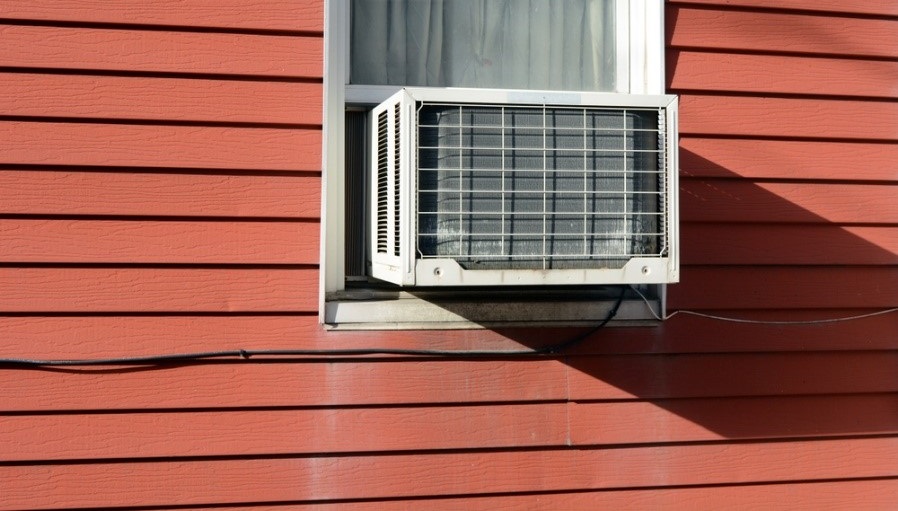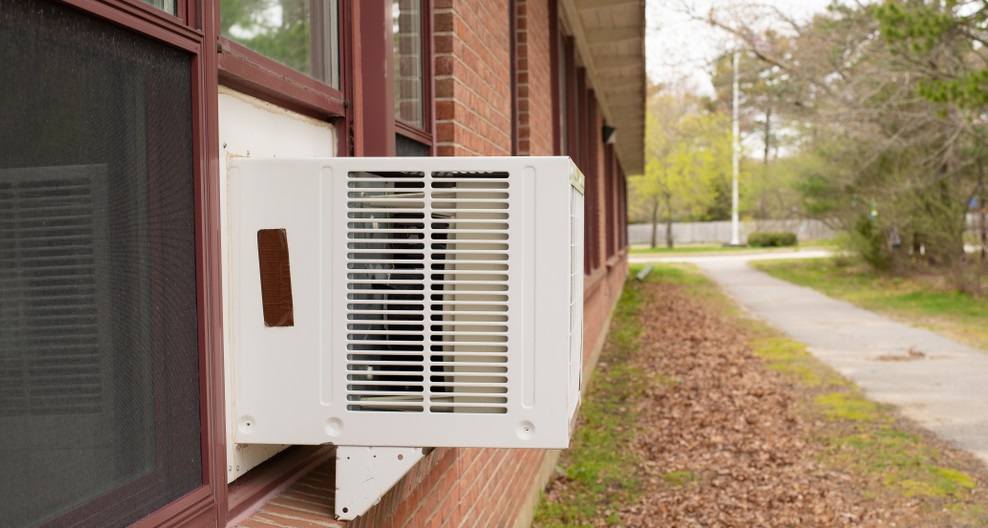
If you have or are considering getting a window air conditioner, you likely know they can be really handy devices that help keep your home’s temperature comfortable and regulated, but exactly how do window air conditioners work?
In short, a window air conditioner employs refrigeration properties to cool air in a room while removing humidity. It’s similar to how a central air conditioner works, although it’s only for one space and not the entire home.
A window air conditioner works in two cycles: a room air cycle and a hot air cycle. The single-unit air conditioner contains all the necessary components in a box-like design.
With that in mind, let’s take a look at the various parts of a window air conditioner and its operating mechanism.
Parts of a Window Air Conditioner
- Compressor: The compressor is like the heart of a human being. It circulates the refrigerant between the evaporator coil and the condenser coil.
- Fan: Sucks in atmospheric air from the surrounding to cool the refrigerant in the condenser coils and pushes back the hot air out into the external environment.
- Blower: Circulates hot air over the evaporator coils for cooling and then channels the cool air back to the room.
- Condenser coils: Cools down the hot outdoor air that comes into the AC unit.
- Evaporator coils: Contains refrigerants that remove heat and humidity from the incoming air.
- Refrigerant: The cooling chemical substance in the evaporator coils.
- Air filter: Traps dirt and dust particles from the incoming air.
- Control temperature and flow rate of the cold air.
- Expansion valve: Employs the process principle of throttling to lower refrigerant temperatures.
Layout of a Window Air Conditioner: Interior Components
At the center of a window air conditioner unit are the compressor and the fan motor. On the indoor side, there is an air filter immediately after the cover. It is followed by an evaporator and evaporator blower.
On the outdoor side, the fan motor is attached to the condenser fan and then the condenser. There is also an expansion valve between the evaporator coils and the condenser coils. The thermostat is in-built on the room-facing side. It’s worth noting that the specific layout of the air conditioner’s interior components may vary from one model to another.
How Do Window Air Conditioners Work During The Cooling Process
The cooling process takes place in two cycles: the room air cycle and the hot air cycle.
Room Air Cycle
The main purpose of the room air cycle is to channel the hot air from the room into the air conditioner, cool it and redirect the cool air back to the room.
When you power on the air conditioner, the blower starts immediately, followed by the compressor. Once the compressor starts, it causes a drop in temperature in the evaporating coils. The blower pulls hot air from the room into the window air conditioner. The air may contain dust and dirt particles which the air filter traps and removes.
The filtered air proceeds to circulate over the evaporating coils. As a result, the evaporating coil’s temperature is considerably lower than the incoming air from the room. The temperature gradient causes the refrigerant to absorb the heat from the air.
Also, the coil’s temperature is lower than the room’s dew point, which causes dew to deposit on the surface of the evaporating coil, removing humidity from the air.
The blower sucks the cool, low humidity air into the air conditioner and expels it at high speeds through the metal ducts and front panels back to the room.
The Hot Air Cycle
As the refrigerant in the evaporator coils absorbs heat, its temperature rises, and eventually it converts into vapor, which is pushed to the condenser coils. When the vaporized refrigerant enters the condenser coils, it undergoes a condensation process and liquefies.
During the hot air cycle, atmospheric air comes into play to cool the condenser coil and the refrigerant. The condenser fan pulls in atmospheric air and blows it over the condenser coils. It cools the refrigerant, and the hot air is pushed out back to the environment. The cooled refrigerant passes through the expansion valve back to the evaporator coils to facilitate the cool air cycle.
The expansion valve operates through a process of throttling. It reduces the speed of the refrigerant by passing it through a narrow pathway before releasing it to evaporating coils, which have a larger surface area. It causes the refrigerant pressure to drop further for enhanced efficiency in the cool air cycle.
The Role of the Thermostat
The room air cycle and the hot air cycle takes place continuously and happen at a high speed. Therefore, with each bout of cool air pushed out to the room, the overall humidity and temperature in the room lower.
Over time, the room temperature reaches a desirable equilibrium — and this is where the thermostat kicks in. It temporarily halts the compressor and stops or slows down the cooling cycle.
Once the AC unit ceases to cool the air, the room temperatures will gradually rise. When they reach the preset temperature, the thermostat triggers the unit to come back on and for the cooling process to resume.
How to Improve the Efficiency of a Window Air Conditioner

In addition to the tips below to improve the efficiency of a window air conditioner, you may also want to consider the best air purifier for dust removal and allergies. This way, the house can stay cleaner and there is less dust in the home to threaten the efficiency of your window AC unit.
Adjust the Air Conditioner’s Speed Accordingly
Increasing the air conditioner’s speed quickens the cooling process if the ambient temperatures are too high. Usually, it increases the blower’s speed and consequently the rate at which it blows hot air from the room and cool air back to the room.
Clean the Filters Regularly
The filters play a crucial role in keeping dirt and dust off the internal components of your window air conditioner. If the dirt and dust get into the air conditioner, it will deposit on the evaporator coil, fan, blower, compressor, and condenser, lowering their efficiency.
If the air filters are dirty, you may notice that the air conditioner releases warm air to the room rather than cool air. You may also notice an increase in your energy bill. The blower may also recirculate the dirt and dust back to the room, causing you to sneeze or cough.
Regularly clean the filters. If the filter is disposable, replace it with a new one if it becomes too dirty and clogged or has exhausted its lifespan.
Clean the Coils
For optimal efficiency, the coils need to be completely clean to maximize the heat exchange process. While the air filter gets rid of most dust and dirt from the incoming air, some dirt and dust may manage to sneak through other openings on the unit. Therefore, it is important to regularly clean the coils.
Use a soft brush with a mild soap solution to remove any embedded dirt or grime. Then, wipe with a damp cloth and allow them to dry before running the air conditioner again.
Occasionally, Run the Air Conditioner in Fan Mode
You only need to run it in fan mode for a few minutes. It drives out dust and dirt particles and prevents them from settling on the window air conditioner’s internal components.
Install the Window Air Conditioner Properly
If the window air conditioner is not installed properly, it might inhibit airflow in and out of the room. Pay attention to the manufacturer’s recommendations on whether you need to tilt the conditioner to enable it to drain condensation dew.
Bottom Line
Window air conditioners have a simple operating mechanism. High temperatures in a room trigger the thermostat, which causes the blower and the compressor to start running. The blower pulls in hot air from the room and blows it over evaporating coils for cooling.
The cooled air is pushed back to the room while the hot refrigerant is channeled to the condenser for cooling. Once cooled, it is channeled back to the evaporator coils through the evaporator valve, and the cycle continues.
